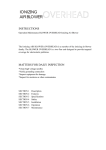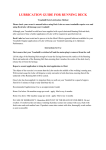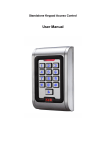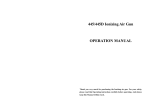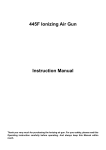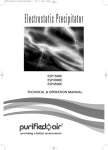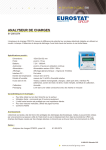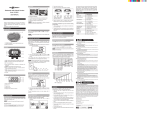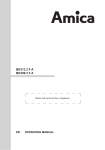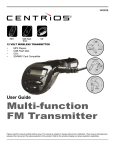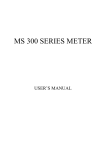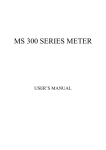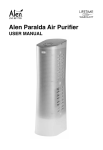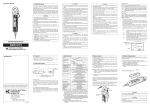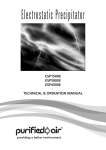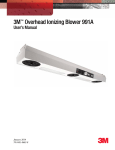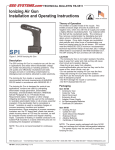Download IONIZING AIR BLOWER
Transcript
IONIZING AIR BLOWER OPERATION PC INSTRUCTION Thank you for purchasing this PC Ionizing Air Blower. It is designed to eliminate the static electricity from a charged object. Please read this manual before operating the static eliminator. Keep this manual readily accessible for reference. Description Thank you for purchasing our Static Eliminator-Ionizing Air blower PC (Adjustable model PC and Alarm model PC). It is designed to eliminate the static electricity from a charged object. Please read this manual before operating the static eliminator. It is important that these instructions be read and understood before attempting to install or operate the equipment. Failure to do so could result in serious personal injury and/or damage to the equipment. +- The series BLOWER PC ionized air blower produces an air flow that is rich in positive and negative ions. Directing the air flow on an object that has a static electricity charge will neutralize the charge. If the object has a negative static charge, it will draw positive ions from the air flow. Conversely, if the object has a positive static charge, it will draw negative ions from the air flow. The air ions are attracted to the oppositely charged object and neutralize the charge on the object. The series BLOWER PC is a portable ionized air blower. It uses a small fan to produce air flow. The volume of air flow is controlled by variable speed control which provides a wide range of air flow settings. The low wattage heating element can be turned on at any time for user comfort(Optional equipment). The ionizing elements are energized with a low current, high voltage transformer. The transformer contains a current limiting electronic element which enhances ionization stability and provides for safety. The high voltage AC is applied to a circular arrangement of stainless steel ion emitter points which results in an intense alternating electric field at the tip of the emitter points. It is this electric field that creates alternating polarity air ions in the air flow. Furthermore, this type of Ionizing air blower is design with automatic alarm function (Alarm model PC). When the blown air can’t eliminate static or the offset of ion balance is too large, the unit is able to automatically give an alarm to prompt. To assure that the unit is working properly, the high voltage AC and ion balance is monitored by sound-light annunciator. The ionizer of the blower features an exclusive balancing circuit. When the balance offset is very small, it can balance automatically. When the offset is too much, and it need to be adjusted by hand. The ionizer of the BLOWER PC has a small brush for cleaning the emitter .Using the point cleaner takes only a few seconds. Cleaning the emitter points on a weekly basis prevents the build-up of airborne debris all electrical ionizers are prone to. This keeps your BLOWER PC working in top form for the life of the unit. The BLOWER PC is designed for use with sensitive electronic components, where electrostatic discharge is a problem. The BLOWER PC can also be used where static electricity causes problems such as attraction of dirt to product, misalignment of small parts due to electrostatic “jumping” and undesirable adhesion of plastic films due to electrostatic charge. Characteristic 1. 2. 3. 4. 5. 6. 7. 8. 9. 10. 11. Compact design, light weight and adjustable angle. Rapidly neutralizes static charges. With the sound-light alarm function. (Alarm model) Wide ion air area. Variable speed fan with wide range of air flow. Ion balance is very steady and able to adjust. Indication lamp display ion output. Adopt leak-magnetism transformer, life is long and prevent short circuit. Durable the grounding metal enclosure. Within cleaner for cleaning ion emitter. Safety and low power heater (The type with warm air device). Specifications Air Volume Output: Fan Speed Low High Air Flow 1.0m3/min 2.4m3/min Air Velocity Fan Speed Low High 30cm 1.4 2.6 60cm. 0.8 1.9 Velocity is measured at center line of air stream. 90cm 0.6 1.3 120cm 0.3 0.9 (Unit: m/s) Efficiency range of ionizing air area: 40cm×150cm Ozone Production: less than 0.01 PPM measured 15cm in front of unit, fan low. Audible Noise: Fan Speed Low 40dB High 45dB Measured 1m from unit. Optional Air Filter: 30 PPI Open Cell Polyurethane Foam Ion Balance (offset voltage): less than ± 5V when regulating in the company, determined as association standard ANSI/ESD-S20.20-1999 Eliminating static time (s): Fan Speed – High 30cm. 2.7 1.2 2.7 60cm 3.5 2.4 3.5 90cm 5.7 4.2 5.7 120cm 6.7 15cm 6.1 Center Line 6.7 15cm 60cm 6.2 4.2 6.2 90cm 9.3 7.1 9.3 120cm 10.4 15cm 10.3 Center Line 10.4 15cm Fan Speed – Low 30cm. 5.1 1.9 5.1 1) Offset voltage and discharge time determined as American Standard ESD-STM 3.1-2000 and ANSI/EOS/ESD-S3.1-1991 using CPM374 charged plate analyzer. 2) Discharge times are in seconds from 1000 volts to 100 volts at locations shown. 3) Above testing value can be changed with difference of temperature, humidity and ambient environment. Heated Air Temperature: (Optional equipment) Fan Speed Above Ambient Low 12℃ High 5℃ Measured 15cm in front of unit. Operating Temperature: 0℃--50℃ Enclosure: steel Weight: 2.6Kg Dimension 14.0cm(W) X 22.0cm (H) X 8.4cm (D) (without power cord) Safety instruction Please read the instruction manual completely before operating the device. This machine is equipped with a 3-wires grounding plug and must be plugged into a 3-terminal grounded socket. Do not modify plug or use an ungrounded power socket. If an extension cord is necessary, use only a 3-wire extension cord that provides grounding. To prevent accidents and failures, be sure to observe the following precautions: 1) Do not insert any object through intake or outlet grille. 2) Do not operate the device under inflammable or explosive atmospheres. 3) Do not touch the electrodes while the power is on. 4) Turn the power off after using. 5) Turn the power off when changing parts or storing the unit. 6) Do not wet the unit or use the unit with wet hands. 7) Do not modify the unit. 8) Remove power cord by holding the plug-not the cord. Installation 1.The ionizing blower is generally placed at one end of the workbench or area to be neutralized. It may also be mounted on wall or mounted on a shelf. If the bench stand is bolted in place ,use φ4mm diameter screws or bolts to secure it. 2. For proper operation, the unit must be grounded for safe operation. The ionizing blower should be placed approximately 1 to 3 feet from the critical work area or objects to be neutralized. It should be positioned to cover as much of the area as possible with the ionized air stream. The closer the unit is to the charged body, the higher the static eliminating effect will be. The air stream can be directed upward or downward by tilting the unit in its stand. Loosen the angle adjusting knob. Direct the unit toward the charged body from which you wish to eliminate static electricity. Adjust the position and the angle of the unit and tighten the adjusting knob. 3. Under the unclean environment, please install the filtration attached. This filtration includes a fixture and a carbon filter. Put the carbon filter inside the fixture, then fix the fixture to the plastic shield. Press down the edge of fixture slightly, so that the fixture will be locked in. Note: Make figures of the fixture and the shield superpose. Keep the arrowhead down. Inspection before using 1. 2. 3. 4. 5. Clean the ion emitter. Check the grounding. Check the device is good or not. Check humidity and other pollutant. Check whether the used voltage accord with the voltage on the nameplate. Operation 1.Turn on the power switch and the indicator illuminates the presence of ionized air. Set airflow as desired by adjusting fan speed knob. If warm air is desired for operator’ s comfort, turn the heat switch on(Optional equipment). To clean ion emitter points, rotate the point cleaner knob clockwise to the stop (approximately one turn) and release. 2.The time required to neutralize a static charge on an item in the air stream depends on fan speed. Setting a higher fan speed reduces time required to neutralize a static charge. 3. The airflow direction is adjusted by unscrewing the locknuts first, and again sloping the blower 4. When using the unit in an electronics assembly area, the ionized air stream should cover as much of the work area as possible. The constant flow of ionized air will prevent items such as work surfaces, tools, materials and components from developing a static charge. Charged items introduced into a work area will be neutralized and will remain neutral while in the ionized air stream. 5. If the blower make a sound of alarm during working, this indicate that the offset of ion balance is too large or the blown air without positive and negative ions not to eliminate static. The unit should be check Maintenance The ionizer has been designed for minimal maintenance. The only regular maintenance suggested consists of emitter point cleaning, ion balance checking and ion output checking. If the deflection of ion balance is too much, you need to adjust and clean. Emitter point cleaning takes only moments with the point cleaners. The ionizer also contains a balancing circuit that is inherently self-balancing. This circuit compensates for emitter point wear, line voltage fluctuations and variations in air velocity. Scheduled checking of ion output and balance should be considered to assure quality audit requirements. 1. Emitter Cleaning The ion emitters tend to accumulate deposits of dust and dirt. Dirty electrodes reduce the ion output and should be cleaned. After operating a period of time, the ion emitters must be cleaned. To clean the ion emitters: simply rotate the point cleaner knob located at the center of the outlet grille clockwise to the stop (approximately one turn) and release, The spring loaded point cleaning brush will return to its parking spot. Recommended frequency of cleaning is once a week. 2. Air Filter Cleaning Turn the power switch off and unplug the power cord. Remove the air filter from the rear of the unit by unsnapping the filter retainer. Rinse the filter in plain water while gently squeezing. If the dirt is stubborn, wash the filter in mild soap and water then rinse. Blot the filter dry with paper towels and allow to dry. Install filter on air inlet and secure by snapping the filter retainer in place. Note: If an air filter is used, clean the air filter regularly 3. Ion Output Check Use a charged plate monitor to test the unit for ion output. Discharge times and Ion Balance should be measured and checked. Ion Balance and Discharge times can be measured against the table in the SPECIFICATION(Test figures are subject to the variation in the atmospheric conditions). If Charged plate analyzer is not available, a hand held electrostatic field meter is still acceptable. Ion output may be checked using the following procedure: 1) Take a piece of plastic and rub it with cloth until a static charge can be read with the static meter. 2) Turn on the ionizing blower and set fan speed to high. 3) Hold the plastic 1 feet away from center ionized air outlet for five seconds. 4) Remove plastic from ionized air stream and measure static charge. The plastic should be neutralized. If no instrumentation is available, ion output may be verified with the following procedure: 1) Tear-off about a 300mm length of brand transparent tape. 2) Approach non-adhesive side of tape with you free hand and note the electrostatic attraction of tape to your hand. 3) Pass tape through the ionized air stream approximately 300mm from unit and again approach non-adhesive side of tape with your free hand. If the charge has been neutralized, it will not attract. 4. Ion balance adjustment If the ion balance deflection is too much, you can adjust the ion balance. Use the screwdriver to adjust the balance localizer behind the unit. When ion balance lean to positive, adjust clockwise. When ion balance leas to negative, adjust anticlockwise. 5. Daily Inspection 1) Make sure no abnormal odors, smoke, or abnormal noises are emitted from the unit while it is running. 2) If any abnormal odor, smoke, or abnormal noise is observed, discontinue use immediately,turn the power switch off and unplug the power cord from the outlet. contacted our company or our sales agents in your area. Trouble shooting ! Caution: To avoid shock, always unplug the power cord before inspecting the unit △ or changing parts. 1) The unit will not operate when the power switch is turn on. Check 1:Is the fuse blown? Action: Replace the fuse.(Be sure to replace with a fuse of the same rating) Check 2:Is the power cord plugged in? Action: Plug it in. 2) Make a sound of alarm during working. (The air is flowing but the static is not eliminated or the balance offset is too large. For Alarm model ). Check 1:has dust or other foreign matter collected on the electrodes? Action: Clean the tips of the electrodes. Check 2: Is the filter dirty? Action: clean or change the filter. For any problems other than those listed above, contact our company or our sales agents in your area. Optional parts The Blower can be mounted on the optional arm stand to provide a wider range of angles and positions from which to approach the charged body. Arm stand *Specifications and design subject to change without notice.









